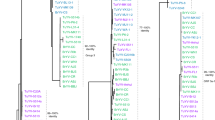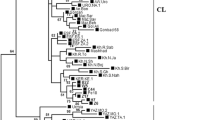Summary
Kennedya yellow mosaic tymovirus (KYMV) occurs along the eastern Australian seaboard in the perennial legumesDesmodium triflorum andD. scorpiurus in the north, andKennedya rubicunda in the south. The genetic variation of more than 100 isolates of KYMV, most of them from the north, has been studied using an RNA hybrid mismatch polymorphism (RHMP) method. The method clearly separated the isolates into two groups; all the northernDesmodium isolates formed one group and all theKennedya isolates from the south another. These sub-populations were themselves variable and theDesmodium population alone was more variable than that of the related turnip yellow mosaic tymovirus in the Kosciusko alpine area.
Similar content being viewed by others
References
Chomczynski P, Sacchi N (1987) Single-step method of RNA isolation by acid guanidinium thiocyanate-phenol-chloroform extraction. Anal Biochem 162: 156–159
Cristina J, Lopez JA, Albo C, Garcia-Barreno B, Garcia J, Melero JA, Portela, A (1990) Analysis of genetic variability in human respiratory syncytial virus by the RNase A mismatch cleavage method: subtype divergence and heterogeneity. Virology 174: 126–134
Dale J, Gardiner JE, Gibbs AJ (1975) Viruses inKennedya rubicunda. Aust Plant Pathol Soc News 4: 13–14
Dale J, Gibbs AJ (1976)Kennedya yellow mosaic virus: another tymovirus. Aust J Biol Sci 29: 397–403
Ding SW, Keese P, Gibbs A (1990) The nucleotide sequence of the genomic RNA of kennedya yellow mosaic tymovirus — Jervis Bay isolate: relationships with potex- and carlaviruses. J Gen Virol 71: 925–931
Ding SW, Howe J, Keese P, Mackenzie A, Meek D, Osorio-Keese M, Skotnicki M, Srifah P, Torronen M, Gibbs A (1990) The tymobox, a sequence shared by most tymoviruses: its use in molecular studies of tymoviruses. Nucleic Acids Res 18: 1181–1187
Domingo E, Martinez-Salas E, Sobrino F, Carlos de la Torre J, Portela A, Ortin J, Lopez-Galindez C, Perez-Brena P, Villanueva N, Najera R, VandePol S, Steinhauer D, DePolo N, Holland J (1985) The quasispecies (extremely heterogeneous) nature of viral RNA genome populations: biological relevance — a review. Gene 40: 1–8
Domingo E, Holland JJ (1988) High error rates, population equilibrium and evolution of RNA replication systems. In: Holland J, Domingo E, Ahlquist P (eds) RNA Genetics, vol 3. CRC Press, Boca Raton, pp 3–35
Fisher AG, Ensoli B, Looney D, Rose A, Gallo RC, Saag MS, Shaw GM, Hahn BH, Wong-Staal F (1988) Biologically diverse molecular variants within a single HIV-1 isolate. Nature 334: 444–447
Gibbs AJ (1978) Kennedya yellow mosaic tymovirus. CMI/AAB Descriptions of Plant Viruses, no. 193
Gibbs AJ, Blok J, Coates DJ, Guy PL, Mackenzie A, Pigram N (1986) Turnip yellow mosaic virus in an endemic Australian alpineCardamine. In: Barlow BA (ed) Flora and fauna of alpine Australia: ages and origins, pp 289–300
Guy PL, Gibbs A (1981) A tymovirus ofCardamine sp. from alpine Australia. Aust Plant Pathol 10: 12–13
Guy PL, Gibbs A (1985) Further studies on turnip yellow mosaic tymovirus isolates from an endemic AustralianCardamine. Plant Pathol 34: 532–544
Kurath G, Palukaitis P (1990) Serial passage of infectious transcripts of a cucumber mosaic virus satellite RNA clone results in sequence heterogeneity. Virology 176: 8–15
Kurath G, Rey MEC, Dodds JA (1992) Analysis of genetic heterogeneity within the type strain of satellite tobacco mosaic virus reveals several variants and a strong bias for G to A substitution mutations. Virology 189: 233–244
Kurath G, Heick JA, Dodds JA (1993) RNase protection analyses show high genetic diversity among field isolates of satellite tobacco mosaic virus. Virology 194: 414–418
Myers RM, Larin Z, Maniatis T (1985) Detection of single base substitutions by ribonuclease cleavage at mismatches in RNA:DNA duplexes. Science 230: 1242–1246
Promega Protocols and Applications Guide, 2nd ed (1991) Promega, 422 pp
Rietveld K, van Polgeest R, Pleij CWA, van Bloom JH, Bosch L (1982) The t-RNA-like structure of the 3′ terminus of turnip yellow mosaic virus RNA. Differences and similarities with canonical tRNA. Nucleic Acids Res 10: 1929–1946
Rodriguez-Cerezo E, Garcia-Arenal F (1989) Genetic heterogeneity of the RNA genome population of the plant virus U5-TMV. Virology 170: 418–423
Rodriguez-Cerezo E, Moya A, Garcia-Arenal F (1989) Variability and evolution of the plant RNA virus pepper mild mottle virus. J Virol 63: 2198–2203
Rodriguez-Cerezo E, Moya A, Elena SF, Garcia-Arenal F (1991) High genetic stability in natural populations of the plant RNA virus tobacco mild green mosaic virus. J Mol Evol 32: 328–332
Sakai K, Dewhurst S, Ma X, Volsky DJ (1988) Differences in cytopathogenicity and host cell range among infectious molecular clones in human immunodeficiency virus type 1 simultaneously isolated from an individual. J Virol 62: 4078–4085
Sambrook J, Fritsch EF, Maniatis T (1989) Molecular cloning: a laboratory manual, 2nd ed. Cold Spring Harbor Laboratory Press, Cold Spring Harbor
Skotnicki ML, Mackenzie AM, Gibbs AJ (1992) Turnip yellow mosaic virus variants produced from DNA clones encoding their genomes. Arch Virol 127: 25–35
Skotnicki ML, Ding SW, Mackenzie AM, Mo JQ, Gibbs AJ (1993) RNA hybrid mismatch polymorphisms in Australian populations of turnip yellow mosaic tymovirus. Arch Virol 132: 83–99
Srifah P, Keese P, Weiller G, Gibbs A (1992) Comparisons of the genomic sequences of erysimum latent virus and other tymoviruses: a search for the molecular basis of their host specificities. J Gen Virol 73: 1437–1447
Steinhauer DA, Holland JJ (1987) Rapid evolution of RNA viruses. Annu Rev Microbiol 41: 409–433
Van Vloten-Doting L, Bol JF (1988) Variability, mutant selection, and mutant stability in plant RNA viruses. In: Holland J, Domingo E, Ahlquist P (eds), RNA Genetics, vol 3. CRC Press, Boca Raton, pp 37–52
Winter E, Yamamoto F, Almoguera C, Perucho M (1985) A method to detect and characterize point mutations in transcribed genes: amplification and overexpression of the mutant c-Kr-ras allele in human tumor cells. Proc Natl Acad Sci USA 82: 7575–7579
Author information
Authors and Affiliations
Rights and permissions
About this article
Cite this article
Skotnicki, M.L., Mackenzie, A.M. & Gibbs, A.J. Genetic variation in populations of kennedya yellow mosaic tymovirus. Archives of Virology 141, 99–110 (1996). https://doi.org/10.1007/BF01718591
Received:
Accepted:
Issue Date:
DOI: https://doi.org/10.1007/BF01718591




